|
< Earlier Kibitzing · PAGE 2 OF 2 ·
Later Kibitzing> |
| Aug-25-14 | | stacase: I spent too much time looking for the obligatory Monday Queen sacrifice and some more time before I realized White had a second Rook. Well OK, way less than a minute overall, but it didn't jump out at me. |
|
| Aug-25-14 | | Once: <patzer2> That's a great piece about how to get out of checks. I wonder if we can elaborate on it? How do we find the move 29. Rxh7+ in the first place? One way to think about it is that chess isn't only a game about 64 squares. When it comes to giving checkmate, it reduces down to a game of 9, 6 or 4 squares. We win if we can control all of the squares around the enemy king - including the square that the king is standing on. Controlling a square means that we either cover it with a piece or the opponent has one of his own pieces standing on it. If the king is in the middle of the board, that means we need to control 9 squares. It's harder, but not impossible. If he is at the edge of the board, we need to control six squares. If he is in the corner we need just four squares...
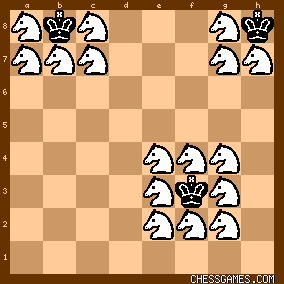
click for larger viewIn today's puzzle, the black king is nearly trapped in the corner. We control every important square except one - the one he is standing on - h8. He is glued in place with nowhere safe to run to. 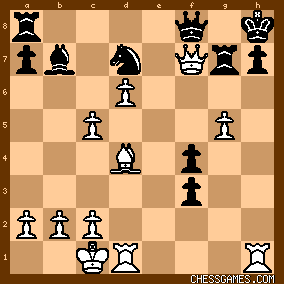
click for larger viewIf we can give checkmate it ends the game. So how can we get to the h8 square? We don't mind how many pieces we give up as long as we give mate. Now we need to try different moves. Rxh7+, Qg8+, Qxg7+ and Bxg7+ all attack h8. We need to try each one in turn to see if black can defend. And by a process of trial and error we find that 29. Rxh7+ Kxh7 30. Rh1+ is the only sequence of moves that gives checkmate. |
|
| Aug-25-14 | | morfishine: 29.Rxh7+ Kxh7 30.Rh1#
<patzer2> & <Once> Interesting posts this Monday Morning ***** |
|
| Aug-25-14 | | zb2cr: 29. Rxh7+, Kxh7. Now we have a back-rank mate turned on its side. 30. Rh1#. |
|
| Aug-25-14 | | Nick46: Today was fairly difficult for a very easy in that there are 5 possible moves to put black in check. |
|
| Aug-25-14 | | Retireborn: Is this the John Turner who was at the Mary Hare school (England) in the 70s, does anybody know? |
|
Aug-25-14
 | | Sally Simpson: As abuzic points out the puzzle could be rolled back. I think the position before White's 28th move is more instructive.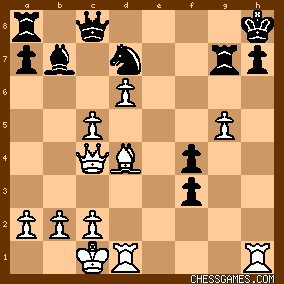
click for larger view
White to play.
It clealry demonstrates the strength of attackers out numbering defenders. Two exchanges strip the King naked. 28.Bxg7+ Kxg7 29.Rxh7+ Kxh7 30.Qf7+ mates.
28 Qf7 was a luxury 'too be sure move.'
♖♖♖
Traditionally you need a Knight for Anastasia's Mate. Just like Philidor's Legacy there is usually a series of forced moves moves leading to the final mate.
Ne7+, Qxh7+ and Rook to the h-file mate.
Here is a perfect example of it's execution.
W Berryman vs E Straat, 1919 |
|
Aug-25-14
 | | gawain: Amusing. Black's advanced pawn on f3 is a liability, as it protects White's mating rook on h1. |
|
Aug-25-14
 | | Penguincw: Alright! Easy Monday puzzle with the rook sac, but not quite sure what kind of mate (looks kinda like Anastasia). |
|
| Aug-25-14 | | Chess Dad: I love Mondays! 28. Rxh7+ Kxh7 29. Rh1#.
Doing these problems has shown me some of my weaknesses. I'm not looking at the entire board before starting to select moves. I considered 28. Rxh7+ as the first move very early, but couldn't seem to make it work after Black's response of 28... Rg7xh7. It was only after looking a little broader that I saw the Rg7 was pinned by the Bd4, and thus the only possible response to 28. Rxh7+ was 28... Kxh7. Granted, that entire process still took less than a minute, but it probably indicates that I need to look more broadly to fully understand the position <before> trying to select moves. |
|
| Aug-25-14 | | patzer2: <Once> Great, clear instructive post explaining the basics of checkmate, by illustrating the King's flight squares with opposite color Knights! I'll definitely incorporate your post in my Chess lessons with my youngest grandchildren. One active three-year-old grandson just "broke" his first board (with a little help from two martial arts instructors) to earn his yellow belt in Tae Kwan Do, and by next year I think he'll be ready to sit still long enough to start learning Chess. P.S.: The five-year-old grandson (three-year-old's brother), who now plays Chess online and has a greenbelt in Tae Kwan Do, has gone through two beginner Chess books with me and for Christmas is asking for another Chess book we can go through together. |
|
| Aug-25-14 | | Mating Net: <28 Qf7 was a luxury 'too be sure move.'> That's domination, pure and simple. White could even afford the extra tempo. |
|
| Aug-25-14 | | Lighthorse: Ah - I love easy-peasy Mondays!
<Phony Benoni>'s comment about Anastasia's mate reminded me of an old book I have that I'll have to pull out and reread in prep for some of the later week puzzles. It's "The Art of the Checkmate" by Georges Renaud and Victor Kahn. Looking through that book right now, I would say this puzzle is similar to Greco's mate (the white Queen as the bishop, and the black Rook as the pawn but pinned): 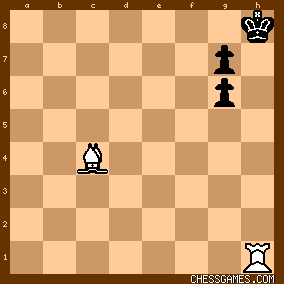
click for larger view |
|
| Aug-25-14 | | patzer2: Two corrections to my original post:
The fourth way to defend an attacked piece (other than the King): 4. Support the attacked piece (not the attacker).
Question: Why can't the Rook on g7 interpose with 29... Rg7xh7? (not 29...Rg7?) P.S.: Thanks <Chess Dad> for your post, which reminds me the combining of the decoy and pinning tactic to force a mating position (e.g. 29. Rxh7 Kxh7 forced) is a difficult concept for most new players. |
|
| Aug-25-14 | | kevin86: Check with one rook and mate with the other. The queen is not sacrificed, just used as a guard to keep the king on the h-file. |
|
| Aug-25-14 | | estrick: The position here after White's 13th move shows Black seriously lagging in development. Although Black is still holding onto the gambit pawn, Fritz's evaluation at 19 ply favors White by 2.64 points. It's almost surprising that it takes White 16 more moves to finish Black off. 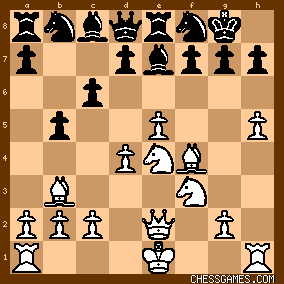
click for larger view. |
|
| Aug-25-14 | | whiteshark: <29.Rxh7+ Kxh7 30.Rh1#> ends the game |
|
| Aug-25-14 | | estrick: Fritz says 15.h6 is best; that 15. g4 gave away at least a point of his advantage. Exchanging his knight on d6 was bone headed, (h6! was still indicated). After 17.exd6, Black had the opportunity to pull the evaluation all the way back to 0.02 if he had played 17 ...c6, instead of Nd7. And that's why the game continued on for 29 moves . . . |
|
| Aug-25-14 | | BOSTER: <Phony Benoni: Definitions aside>.
And the Rules in the same way.
Every seduction begins with a move like this. |
|
| Aug-25-14 | | Refused: 29.Rhx7+ and lights out.
Instead of 28...Qf8
28...Qg8 was marginally better. Means it prolongs the mate. 28...Qg8 29.Rxh7+ Qxh7 30.Bxg7+ Qxg7 31.Rh1+ Qh7 32.Q/Rxh7# |
|
| Aug-25-14 | | ruzon: <patzer2: A useful acronym is BATS (Block, Away, Take and Support)> I teach my young club members something similar, but I call it ABCDE: run Away
Block
Capture
Defend, and the one you didn't mention:
something Else (I used to call it "Egnore")
"Something Else" refers to ignoring the threat and and creating a more important one elsewhere. Otherwise kids worry about losing a pawn and don't notice they can take a rook. Then when the king is in check, it's just the ABC rule. And if it's a double check, only A works. |
|
| Aug-25-14 | | patzer2: <ruzon> Excellent! I'll use ABCDE along with BATS in my instruction. Didn't mention ignoring an attack as a defense. However, if an opponent has to delay or forego an attack to defend against a greater threat, such as mate, then your "something Else" is certainly a legitimate means of defense against an attack on a Chess piece. |
|
| Aug-25-14 | | patzer2: <ruzon> Your "something else" is illustrated in this game with White's 27th move 27. Bd4!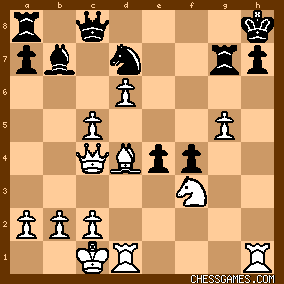
click for larger viewHere White has ignores the pawn's attack on his Knight to play 27. Bd4! with a mating attack. While 27. Bd4! is decisive, White could've played
27. Rxh7+! right away with mate-in-five after 27. Rxh7+ Rxh7 (27... Kxh7 28. Rh1+ Kg6 29. Qe6+ Nf6 30. Qxf6#) 28. Bd4+ Ne5 29. Bxe5+ Rg7 30. Rh1+ Qh3 31. Rxh3#. P.S.: Black missed his best chance early in the game by not playing 3...Qh4+! 4. Kf1 Nf6  with the attack, the initiative and the advantage. Even 5...Qh4+! 6. Kf1 Nf6 = was not too late. However, after 5...Nf6?! 6. e5! Ng8? with the attack, the initiative and the advantage. Even 5...Qh4+! 6. Kf1 Nf6 = was not too late. However, after 5...Nf6?! 6. e5! Ng8?  to to  it went down hill for Black. it went down hill for Black. |
|
| Aug-25-14 | | abuzic: The puzzle's theme move is portrayed as ♘ sac 27.Bd4; actually ♖ sac
27.Rxh7+ leads to quick forced mate:
27.Rxh7+ Rxh7
<27...Kxh7 28.Rh1+ Kg6 29.Rh6+ Kf5 30.Qf5# (or 29.Qe6+ Nf6 30.Qxf6 or Rh6#>28.Bd4+ Nf6 (or ...Ne5) <28...Rg7 29.Rh1#> 29.BxN+ Rg7 30.Rh1+ Qh3 31.Rxh3# |
|
Oct-30-20
 | | fredthebear: I agree with <<Lighthorse...this puzzle is similar to Greco's mate (the white Queen as the bishop, and the black Rook as the pawn but pinned):> It's a Greco's Mate pattern on the h-file w/some units playing different roles. Anastasia's Mate also hits home on the h-file. Both should be known by heart. The attacking knight plays different roles to differentiate each pattern. The flexible Greco's mate pops up frequently on the kingside when the f-pawn has been advanced/removed, and one or both h-pawns are removed. Some of the more famous Greco's Mate examples in the opening just after castling involve attacking B-N-Q w/the Q mating on the h-file, whereas middlegames tend to include one or both rooks on the h-file delivering mate. * https://srteitsson.wixsite.com/rest... * https://chessfox.com/grecos-mate/
* Like a Reinfeld puzzle book brought to life! https://dailychessmusings.com/check... * A sequence of 5-7 minute videos showing games w/Greco's Mate: https://www.bing.com/videos/search?... * https://www.chesstactics.org/mating... * Use the small blue link to PREVIEW "The Art of the Checkmate": https://books.google.com/books/abou... |
|
 |
|
< Earlier Kibitzing · PAGE 2 OF 2 ·
Later Kibitzing> |





































